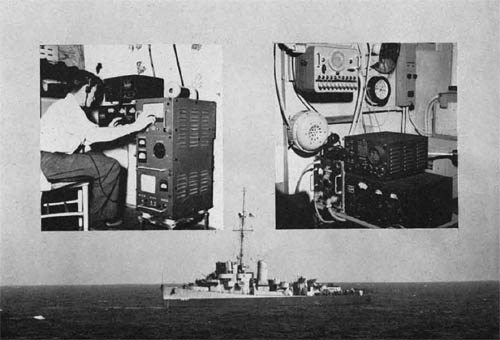
Posted: 4/2/2014 10:30:06 PM EDT
[#2]
Part 3: ECM and ECCM
The successful attacks on Allied ships off Sicily and Salerno triggered a rush to find a way to stop the guidance.

Ships were modified with equipment to find what radio frequencies the Germans were using and jam them. Later, during the invasion of Italy, the actual German equipment was captured.
"Meanwhile two U.S. destroyer escorts were fitted out with special search receivers covering the entire radio spectrum from 15 kc. to 3000 Mc, panoramic adaptors, recording and photographic equipment, and jammers (constructed by the Naval Research Laboratory) to operate from 10-35 Mc.
The mission of the two DE’s was two-fold: (a) to find and record the frequencies and modulation for control of the bombs, and (b) to jam them.
The ships selected for this ticklish assignment were the USS FREDERICK C. DAVIS (DE 136) and the USS HERBERT C. JONES (DE 137). RCM teams, specially trained at the Special Project School, Radio Material School, Anacostia, D.C., were placed on board each ship. The teams consisted of one officer, two technicians, two operators, and two photographers...
German aircraft, using torpedoes and radio controlled bombs, attacked a convoy off the Algerian coast at dusk November 6. The F. C. DAVIS and H. C. JONES, present in the screen, logged transmissions in the 48-50 Mc band coincident with visual observations of guided missiles being launched. On November 26, during a two-hour attack, reportedly one of the heaviest ever launched against an Allied convoy in the Mediterranean, about 20 control signals were heard. Both ships, having rebuilt their jammers to cover the 48-50 Mc range, jammed many of the signals, and topside personnel stated positively that several bombs went out of control when jamming was applied. The H. C. JONES postponed jamming long enough to record one control signal, and from information obtained the laboratories were able to design suitable modulators for the high-powered jammers then being rushed to completion at the Naval Research Laboratory.
Two of these transmitters—one kw. output—were flown to the Mediterranean and installed in the two DE’s prior to the Anzio landings in late January, 1944. At Anzio the Luftwaffe struck and struck hard, with glider bombs as well as high level and dive bombing attacks. The DE’s, the only ships then fitted with effective jammers, were necessarily retained in the assault area through the long weeks over which the attacks continued. As Task Group 80.2 the ships underwent more than seventy-five air attacks in forty-eight days, earning official commendation in dispatches from CominCh and Commander Eighth Fleet. During this period more than one hunclred guided missile signals were intercepted and jammed—not with complete success, apparently, for several ships were hit by these bombs. No U.S. warship was hit, however, and the percentage of hits was sharply reduced."
http://www.lonesentry.com/blog/how-radio-controlled-bombs-were-jammed.html
USN on-ship jamming equipment:

The Germans reacted to the radio jamming by introducing fly-by-wire control.
"Luftwaffe activity in Italy led to the compromising of the Hs-293A series when Allied forces captured intact crated Fritz-X and Hs-293 hardware at Foggia airfield, and were able to devise a radio command link jammer, rapidly built and deployed to fleet units.
The Hs-293B was devised as a counter to FuG-230b jamming, and used a wire guidance scheme, unwinding up to 12 kilometres of cable from a spool attached to the tail of the weapon. A FuG-207 Dortmund transmitter and FuGz-237 Duisburg receiver replaced the Kehl III/FuG-230b radio link. Source disagree on the number of Hs-293B built and used in combat."
They also introduced television guidance in the Hs 293D model.
"The Hs-293D was an important milestone since it introduced a nose mounted television camera and radio uplink to the launch aircraft, the aim being for the bomber to attack through an overcast. This variant was distinctive due to the use of a tail mounted Yagi array for the video uplink, and a reshaped nose for the camera aperture. The first successful trials were conducted in August, 1944, using Seedorf 3 and Tonne 4a guidance equipment. German sources claim 255 were built, and at least one source claims a Royal Navy warship was hit by a Hs-293D."
http://www.ausairpower.net/WW2-PGMs.html
These upgrades came too little, too late, as the requirement for straight and level flight for an extended period in order to guide the bombs made the bombers an easy target in an era of Allied air superiority.
"Hs 293 missiles were deployed against the Allied landing at Anzio (as did the Fritz X bombs) in January 44 , but allied fighter cover, radio jammers and smoke screens made the missiles a lot less effective. But the Cruiser HMS Spartan was hit by a missile and sank. (other sources claim the kill was made by a X1 guided bomb)
As with the Fris X bomb, much hope was given to the missiles use against shipping when the major allied Invasion of Europe came. But as shown before, the Bombers had a hard time performing when there was little or no Luftwaffe fighter cover, and the planes were either brought down or forced to abandon the target run before the missile struck home."
http://www.1jma.dk/articles/1jmaluftwaffegroundweapons.htm
|
 Win a FREE Membership!
Win a FREE Membership!